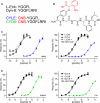Photoactivatable neuropeptides for spatiotemporally precise delivery of opioids in neural tissue
- PMID: 22284180
- PMCID: PMC3282187
- DOI: 10.1016/j.neuron.2011.11.016
Photoactivatable neuropeptides for spatiotemporally precise delivery of opioids in neural tissue
Abstract
Neuropeptides activate G protein-coupled receptors to acutely modulate cellular excitability and synaptic transmission. However, due to the lack of reagents for precise delivery of peptides within dense brain tissue, the spatiotemporal scale over which neuropeptides act is unknown. To achieve rapid and spatially delimited delivery of neuropeptides in mammalian brain tissue, we developed photoactivatable analogs of two opioids: [Leu⁵]-enkephalin (LE) and the 8 amino acid form of Dynorphin A (Dyn-8). These peptides are functionally inactive prior to photolysis, and exposure to ultraviolet (UV) light causes clean release of LE and Dyn-8. Recordings from acute slices of rat locus coeruleus (LC) demonstrated that photorelease of LE activates mu opioid receptor-coupled K+ channels with kinetics that approach the limits imposed by G protein-mediated signaling. Temporally precise and spatially delimited photorelease revealed the kinetics and ionic nature of the mu opioid response and the mechanisms that determine the spatial profile of enkephalinergic volume transmission in LC.
Copyright © 2012 Elsevier Inc. All rights reserved.
Figures






References
-
- Alreja M, Aghajanian GK. QX-314 blocks the potassium but not the sodium-dependent component of the opiate response in locus ceruleus neurons. Brain Res. 1994;639:320–324. - PubMed
-
- Beddell CR, Clark RB, Hardy GW, Lowe LA, Ubatuba FB, Vane JR, Wilkinson S. Structural requirements for opioid activity of analogues of the enkephalins. Proc R Soc Lond B Biol Sci. 1977;198:249–265. - PubMed
Publication types
MeSH terms
Substances
Grants and funding
LinkOut - more resources
Full Text Sources
Other Literature Sources
Research Materials

